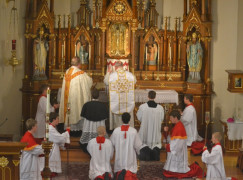

Practicing Lectio Divina
“Ignorance of Scripture is ignorance of Christ.” — St. Jerome, A.D. 340-420
“To get the full flavor of an herb, it must be pressed between the fingers, so it is the same with the Scriptures; the more familiar they become, the more they reveal their hidden treasures and yield their indescribable riches.”– St. John Chrysostom, A.D. 347-407
“The New Testament lies hidden in the Old and the Old Testament is unveiled in the New” — St. Augustine, A.D. 354-430
“All troubles of the Church, all the evils in the world, flow from this source: that men do not by clear and sound knowledge and serious consideration penetrate into the truths of Sacred Scripture.” — attributed to St. Theresa of Avila, A.D. 1515-1582
Lectio Divina (pronounced “Lec-tsee-oh Di-vee-nah”) means “Divine Reading” and refers specifically to a method of Scripture reading practiced by monastics since the beginning of the Church.
The early centrality of reading of Sacred Scripture, and then meditating and praying over its meaning, is evident in the 48th chapter of the Rule of St. Benedict (A.D. 480-453), a book written by the Great Saint to guide monastic life.
But it was an 11th c. Carthusian prior named Guigo 1 who formalized Lectio Divina, describing the method in a letter written to a fellow religious. This letter, which has become known as Scala Paradisi — the Stairway to Heaven — describes a 4-runged ladder to Heaven, each rung being one of the four steps in his method of Bible reading. Those steps, and Guigo’s brief descriptions of them, are:
Lectio (reading): “looking on Holy Scripture with all one’s will and wit”
Meditatio (meditation): “a studious insearching with the mind to know what was before concealed through desiring proper skill”
Oratio (prayer): “a devout desiring of the heart to get what is good and avoid what is evil”
Contemplatio (contemplation): “the lifting up of the heart to God tasting somewhat of the heavenly sweetness and savour”
Continue reading at Fish Eaters








